|
|
|
Sort Order |
|
|
|
Items / Page
|
|
|
|
|
|
|
| Srl | Item |
| 1 |
ID:
096137
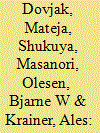

|
|
|
|
|
| Publication |
2010.
|
| Summary/Abstract |
Problem of high energy use for heating in Slovenian buildings is analyzed with exergy and energy analysis. Results of both are compared and discussed. Three cases of exterior building walls are located in three climatic zones in winter conditions. Results of energy analyses show that the highest heating energy demand appears in the case with less thermal insulation, especially in colder climate. If the comparison is made only on the energy supply and exergy supply, the results of exergy analysis are the same as those of energy analysis. The main difference appears, if the whole chain of supply and demand is taken into consideration. Exergy calculations enable us to analyze how much exergy is consumed in which part, from boiler to building envelope. They also reveal how much energy is supplied for the purpose of heating. Results show that insulation has much bigger effect than effect of boiler efficiency. However, the most effective solution is to improve building envelope together with boiler efficiency. Better thermal insulation also makes an important contribution to the improvement of thermal comfort conditions. It causes higher surface temperatures resulting in a larger warm radiant exergy emission rate and consequently better thermal comfort.
|
|
|
|
|
|
|
|
|
|
|
|
|
|
|
|
| 2 |
ID:
110732


|
|
|
|
|
| Publication |
2011.
|
| Summary/Abstract |
Thermodynamic losses usually take place in machineries used for agricultural activities. Therefore, it is important to identify and quantify the losses in order to devise strategies or policies to reduce them. An exergy analysis is a tool that can identify the losses occurred in any sector. In this study, an analysis has been carried out to estimate energy and exergy consumption of the agricultural sector in Malaysia. Energy and exergy efficiencies have been determined for the devices used in the agricultural sector of Malaysia, where petrol, diesel and fuel oil are used to run the machineries. Energy and exergy flow diagrams for the overall efficiencies of Malaysian agricultural sector are presented as well. The average overall energy and exergy efficiencies of this sector were found to be 22% and 20.728%, respectively, within the period from 1991 to 2009. These figures were found to be lower than those of Norway but higher than Turkey.
|
|
|
|
|
|
|
|
|
|
|
|
|
|
|
|
| 3 |
ID:
123595
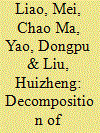

|
|
|
|
|
| Publication |
2013.
|
| Summary/Abstract |
This article uses the concept of embodied exergy as metrics in designing incentive policy instruments to tackle the inefficiency of energy operations. Based on the second law of thermodynamics and energy's economic properties as both a private commodity and a public good, it maintains that energy can be measured by separating the useful exergy embodied in a manufactured product from its waste exergy (anergy) as emissions and sunk wastes in a production process. It is rational to benchmark the content of useful exergy embodied in products for any incentive policy design to encourage green production. This article uses trade data between China, Japan and the EU countries to compare the embodied exergy and waste exergy embodied in traded manufactured products. It proposes using a negative value-added tax as an incentive instrument instead of full-scale carbon tariffs to encourage green production and to fence against carbon evasion behaviour.
|
|
|
|
|
|
|
|
|
|
|
|
|
|
|
|
| 4 |
ID:
108763
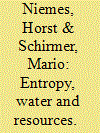

|
|
|
|
|
| Publication |
Heidelberg, Springer, 2010.
|
| Description |
ix, 219p.
|
| Standard Number |
9783790824155
|
|
|
|
|
|
|
|
|
|
|
|
Copies: C:1/I:0,R:0,Q:0
Circulation
| Accession# | Call# | Current Location | Status | Policy | Location |
| 056398 | 333.91/NIE 056398 | Main | On Shelf | General | |
|
|
|
|
| 5 |
ID:
113460
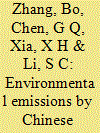

|
|
|
|
|
| Publication |
2012.
|
| Summary/Abstract |
Based on chemical exergy as an objective measure for the chemical deviation between the emission and the environment, a unifying assessment is carried out for major environmental emissions covering COD, ammonia nitrogen, SO2, soot, dust, NOx and solid waste by Chinese industry over 1997-2006, with emphasis on the sectoral and regional levels in 2006. Of the total emission in exergy up to 274.1 PJ in 2006, 67.7% is estimated from waste gases, 29.9% from waste water and 2.4% from solid waste. Five of 40 sectors and 12 of 30 regions are responsible for 72.7% and 65.5% of the total emission, respectively. SO2 is the leading emission type in 9 sectors and 25 regions, and COD in another 28 sectors and 5 regions. Some pollution-intensive sectors such as Production and Distribution of Electric Power and Heat Power and Manufacture of Paper and Paper Products, and western and inland regions such as Guangxi and Ningxia with high emission intensities are identified. By clustering and disjoint principal component analysis with intensities of emissions and fuel coal use as variables, three principal components are extracted, and four statistically significant clusters are pinpointed in the sectoral and regional analysis. Corresponding policy-making implications are addressed.
|
|
|
|
|
|
|
|
|
|
|
|
|
|
|
|
| 6 |
ID:
098596
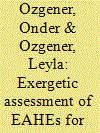

|
|
|
|
|
| Publication |
2010.
|
| Summary/Abstract |
The present study undertakes an exergy analysis of earth to air heat exchanger (EAHE) and applies to a local one in Turkey. Namely, the exergy performance of an EAHE has been evaluated in a demonstration in Solar Energy Institute of Ege University, Izmir, Turkey. Exergetic efficiencies of the system components are determined as an attempt to assess their individual performances. The daily maximum heating coefficient of performance (COP) value for the system is obtained to be 6.18. The total average COP in the experimental period is found to be 4.74.
|
|
|
|
|
|
|
|
|
|
|
|
|
|
|
|
| 7 |
ID:
111431


|
|
|
|
|
| Publication |
2012.
|
| Summary/Abstract |
Exergy analysis has been shown to be an efficient tool for understanding and improvement of industrial processes. In the present study, exergy analysis has been used to examine the energy consumption of an existing Steam Methane Reforming (SMR) process and then to test for possible savings in primary energy consumption and environmental protection.
In the first step, energy and exergy balances of a steam methane reforming process were established to identify the thermodynamic imperfections of the process. Recommendations from this study have contributed to the building of a new and more efficient process. Consequently, a heat exchanger, corresponding to 44.9% of the total required area for the SMR heat exchange, has been incorporated in the SMR for waste heat recovery.
The thermal and exergetic efficiencies of the original process are 70% and 65.5%, respectively. For the new process, the thermal and exergetic efficiencies are 74% and 69.1%, respectively. The unused exergy is reduced by 9.3% from 125.9 to 114.2 kJ per mole of H2 produced. One mole of methane produces 2.48 mol of H2 compared to 2.35 mol of H2 produced in the original process. Furthermore, the new SMR process produces the lower greenhouse gas emissions.
|
|
|
|
|
|
|
|
|
|
|
|
|
|
|
|
| 8 |
ID:
088221


|
|
|
|
|
| Publication |
2009.
|
| Summary/Abstract |
As an effective measure for environmental impact associated with the waste emissions, exergy is used to unify the assessment of the waste gases of CO, NOx, and SO2 emitted from fossil fuel consumption by the transportation system in China. An index of emission exergy intensity defined as the ratio of the total chemical exergy of the emissions and the total converted turnover of the transportation is proposed to quantify the environmental impact per unit of traffic service. Time series analyses are presented for the emission exergy and emission exergy intensity of the whole Chinese transportation as well as for its four sectors of highways, railways, waterways and civil aviation from 1978 to 2004. For the increasing emission exergy with CO taking the largest share, the highways sector was the major contributor, while the railways sector initially standing as the second main contributor developed into the least after 1995. The temporal and structural variations of the emissions are illustrated against the transition of the transportation system in a socio-economic perspective, with emphasis on policy-making implications
|
|
|
|
|
|
|
|
|
|
|
|
|
|
|
|
|
|
|
|
|